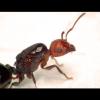I've tried to move two Camponotus into small formicariums when they started eating brood or the brood never developed after months. In both cases, the queens died for no apparent reason soon after I connected their tubes to the founding formicaria.
In one case, the queen spent a few days in the new formicarium roaming around before showing up dead. In another case, I found the queen dead in her tube, having never ventured out of it, about 36 hours later.
My take, even having had these two experiences, is you've got nothing to lose by trying to entice them to move. If they're not rearing brood, they pretty much as good as dead anyway.
If you try to move them, make sure they're moving into a SMALL nest.
Edited by prettycode, August 24 2015 - 2:46 PM.


















